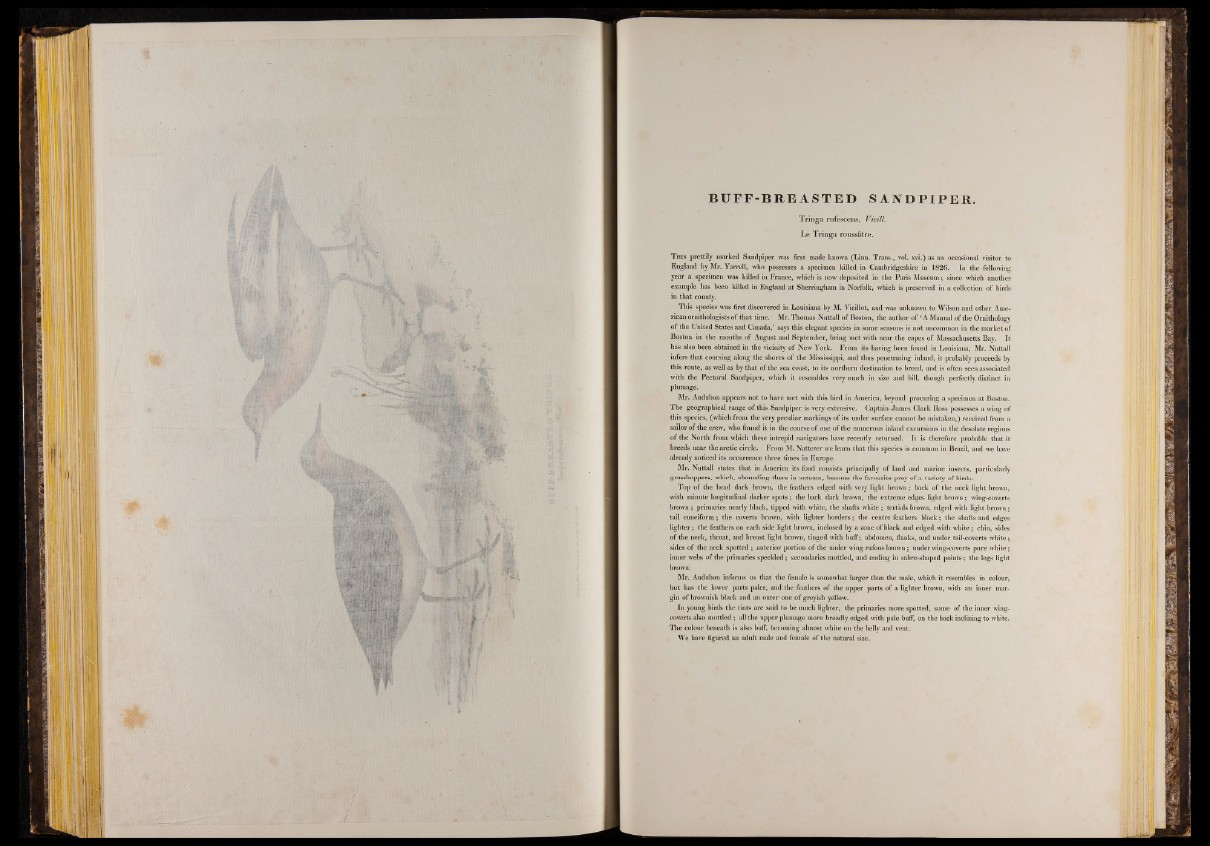
¡ f e i r
BUF F -BREA S T ED SANDP I PE R .
T r in g a rufescens, Vieill.
L e T r in g a rouss&tre.
T h i s prettily marked Sandpiper was first made known (Linn. Trans., vol. xvi.) as an occasional visitor to
England by Mr. Yarrell, who possesses a specimen killed in Cambridgeshire in 1826. In the following
year a specimen was killed in France, which is now deposited in the Paris Museum; since which another
example has been killed in England at Sherringham in Norfolk, which is preserved in a collection o f birds
in that county.
This species was first discovered in Louisiana by M. Vieillot, and was unknown to. Wilson and other American
ornithologists o f that time. Mr. Thomas Nuttall o f Boston, the author of ‘A Manual o f the Ornithology
o f the United States and Canada,’ says this elegant species in some seasons is not uncommon in the market of
Boston in the months o f August and September, being met with near the capes o f Massachusetts Bay. It
has also been obtained in the vicinity o f New York. From its having been found in Louisiana, Mr. Nuttall
infers that coursing along the shores o f the Mississippi, and thus peuetrating inland, it probably proceeds by
this route, as well as by that o f the sea coast, to its northern destination to breed, and is often seen associated
with the Pectoral Sandpiper, which it resembles very much in size and bill, though perfectly distinct in
plumage.
Mr. Audubon appears not to have met with this bird in America, beyond procuring a specimen at Boston.
The geographical range o f this Sandpiper is very extensive. Captain James Clark Ross possesses a wing of
this species, (which from the very peculiar markings o f its under surface cannot be mistaken,) received from a
sailor o f the crew, who found it in the course o f one o f the numerous inland excursions in the desolate regions
o f the North from which these intrepid navigators have recently returned. It is therefore probable that it
breeds near the arctic circle. From M. Natterer we learn that this species is common in Brazil, and we have
already noticed its occurrence three times in Europe.
Mr. Nuttall states that in America its food consists principally o f land and marine insects, particularly
grasshoppers, which, abounding there in autumn, become the favourite prey o f a variety of birds.
Top o f the head dark brown, the feathers edged with very light brown; back o f the neck light brown,
with minute longitudinal darker spots; the back dark brown, the extreme edges light brown; wing-coverts
brown ; primaries nearly black, tipped with white, the shafts white ; tertials brown, edged with light brown;
tail cuneiform ; the coverts brown, with lighter borders; the centre feathers black; the shafts and edges
lighter; the feathers on each side light brown, inclosed by a zone o f black and edged with white; chin, sides
o f the neck, throat, and breast light brown, tinged with buff ; abdomeu, flanks, and under tail-coverts white;
sides o f the neck spotted; anterior portion o f the under wing rufous brown; under wing-coverts pure white;
inner webs o f the primaries speckled; secondaries mottled, and ending in sabre-shaped points; the legs light
brown.
Mr. Audubon informs us that the female is somewhat larger than the male, which it resembles in colour,
but has the lower parts paler, and the feathers o f the upper parts o f a lighter brown, with an inner margin
o f brownish black and an outer one o f greyish yellow.
In young birds the tints are said to be much lighter, the primaries more spotted, some o f the inner wing-
coverts also mottled; all the upper plumage more broadly edged with pale buff, on the back inclining to white.
The colour beneath is also buff, becoming almost white on the belly and vent.
We have figured an adult male and female of the natural size.